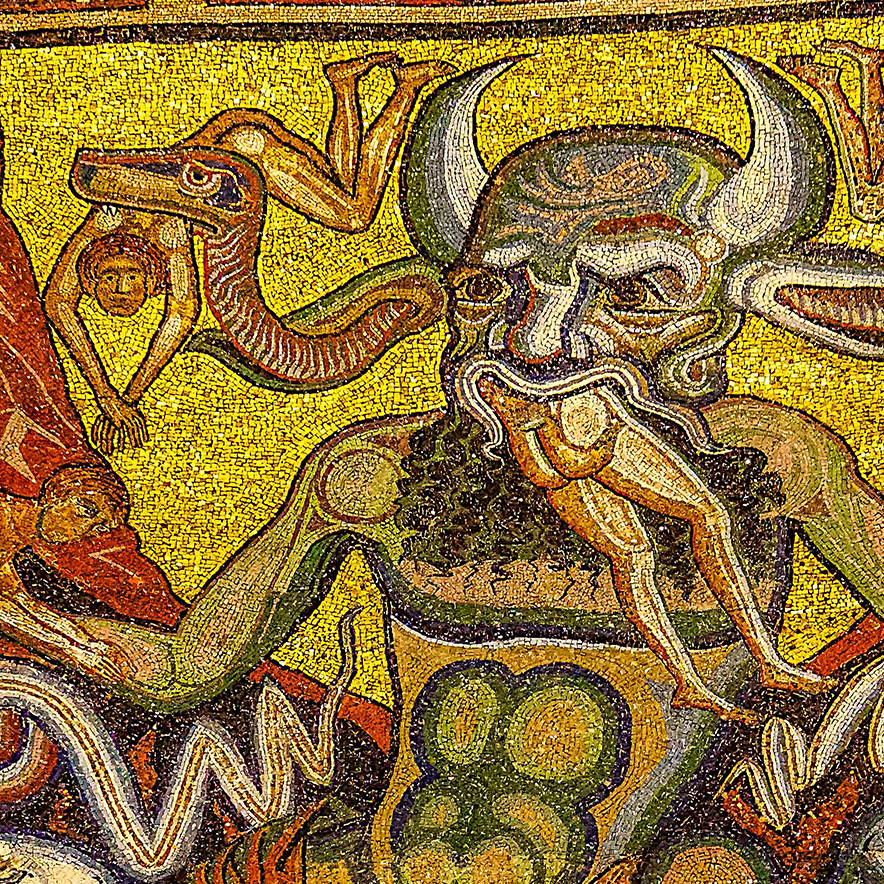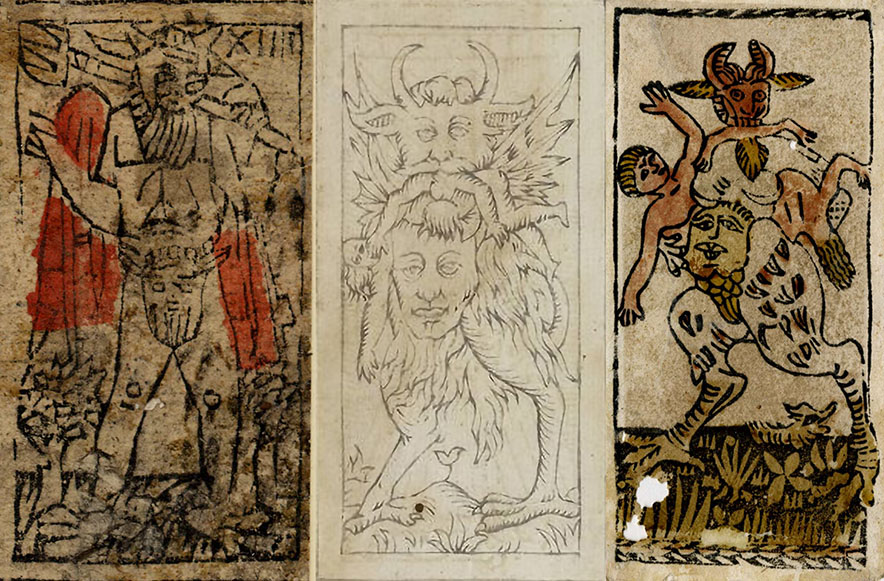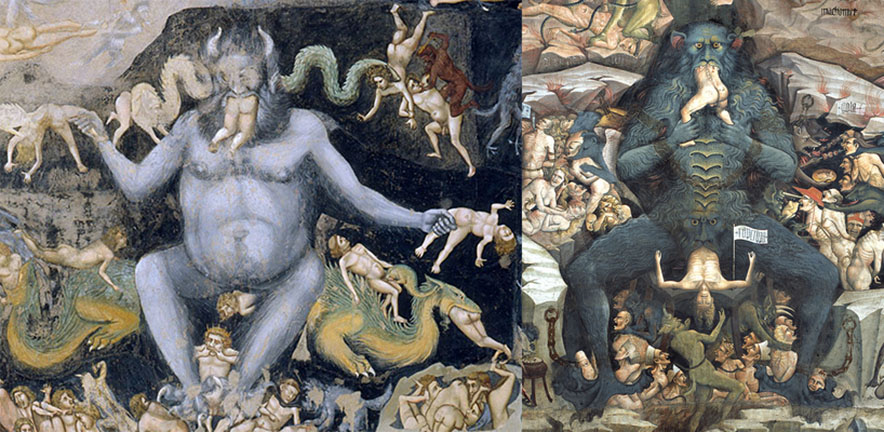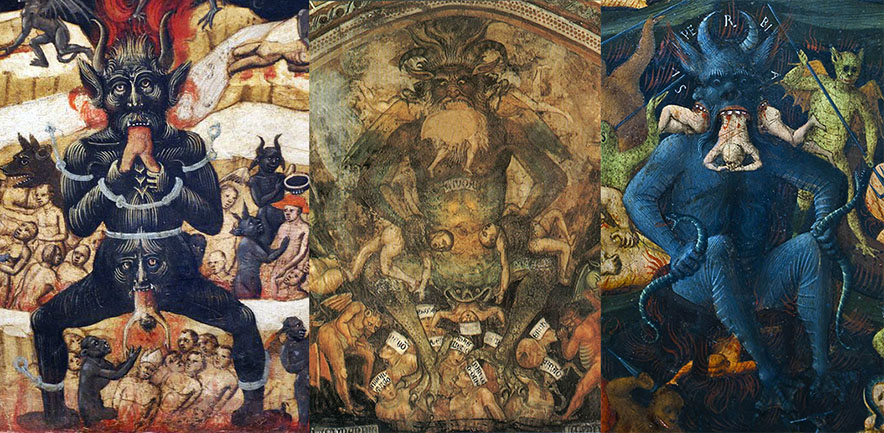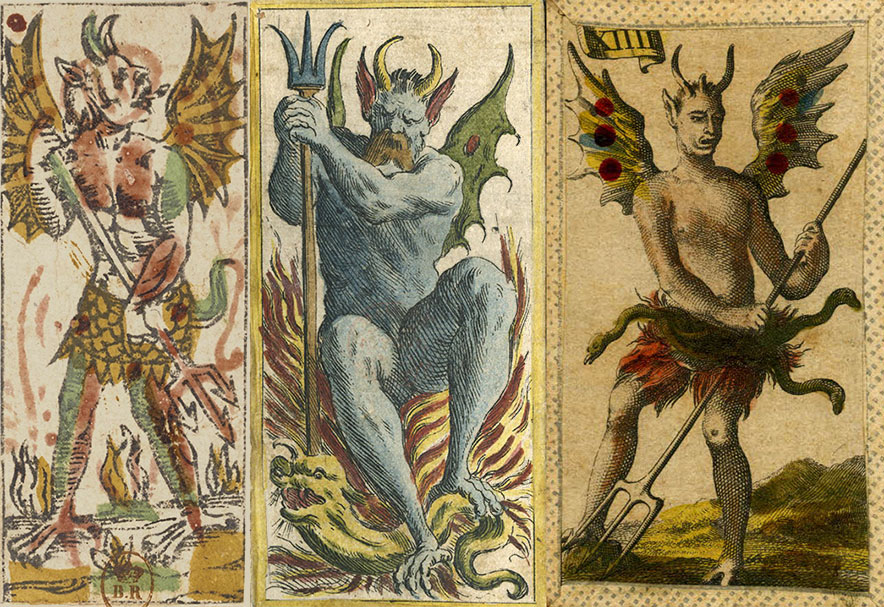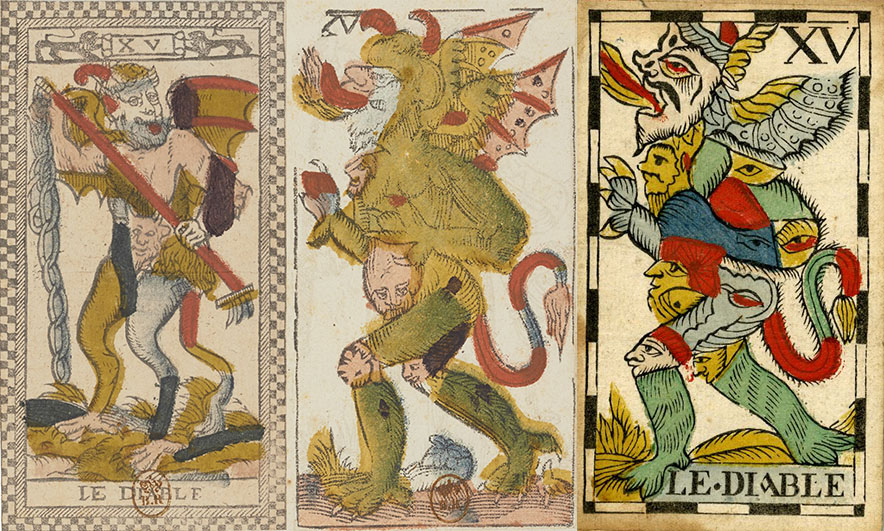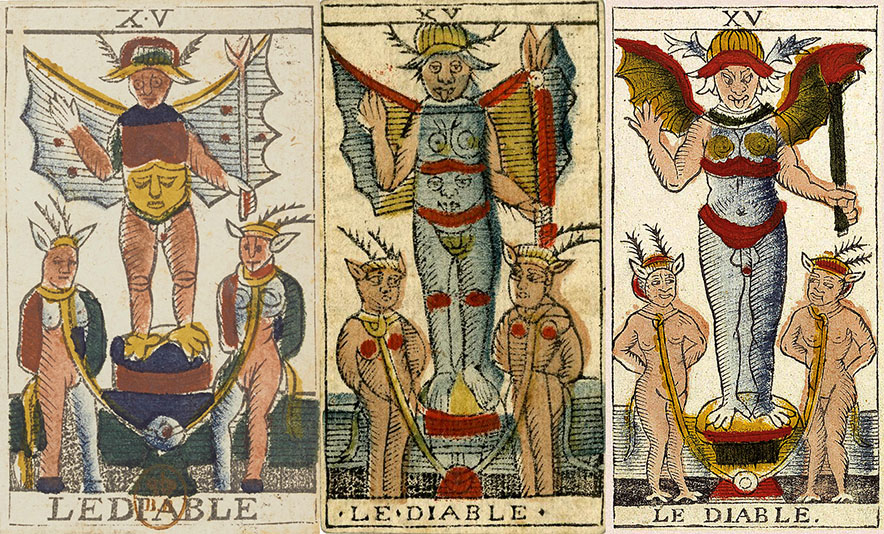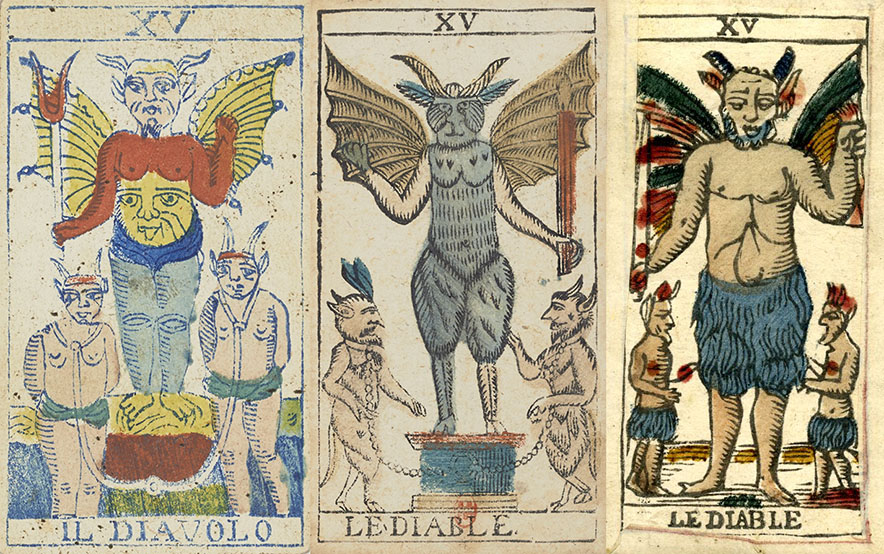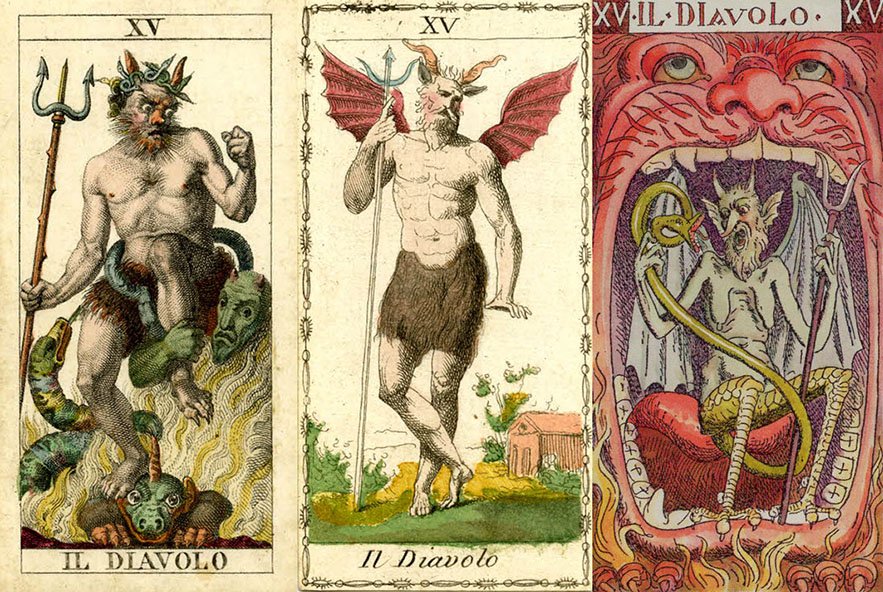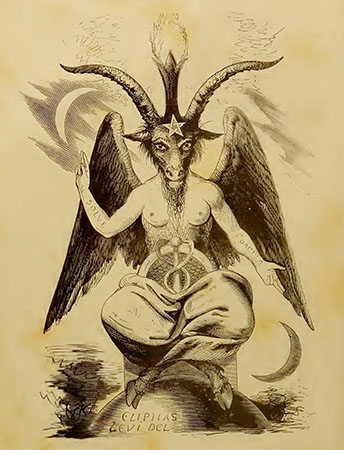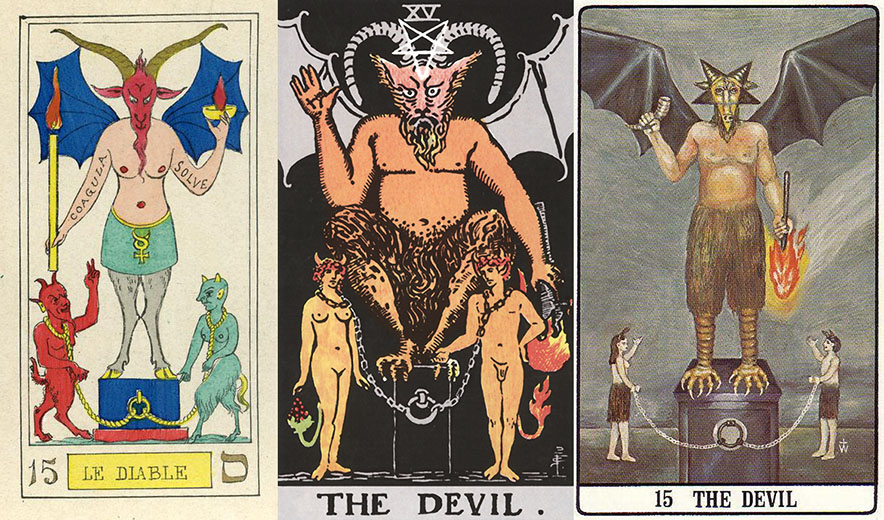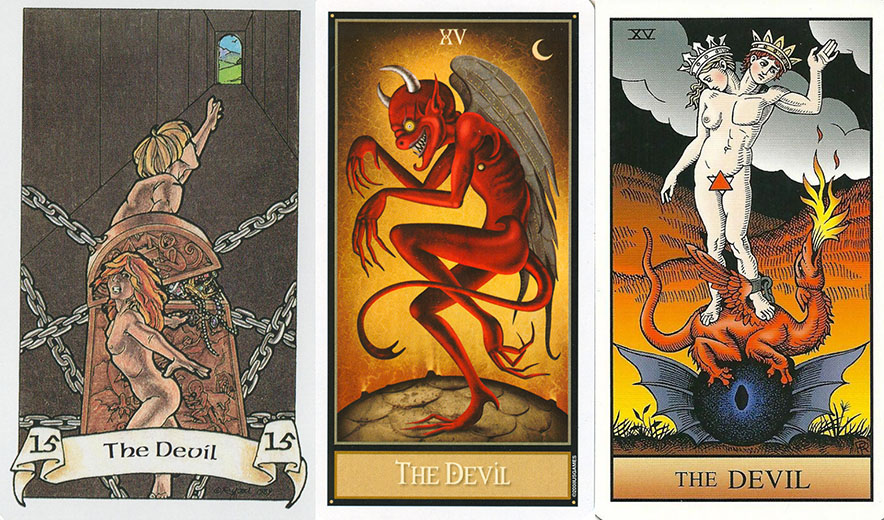THE TAROT WHEEL
IL DIAVOLO - THE DEVIL
This time not a copy of a hand crafted Trionfi card, but a detail of a mosaic made between 1265 and 1270 and attributed to Coppo di Marcovaldo. We can admire this representation of the Devil on the ceiling of the Baptistery in Florence. The reason why I do not show a Trionfi card is rather simple, there are no Trionfi cards known representing the Devil. Were the Italian Dukes too supersticious? Were they afraid of the Devil ? We do not know. The only thing we are pretty sure of, is that the Devil was not represented on the Visconti di Modrone Trionfi deck that had probably only 16 trump cards, nor on the original Visconti Sforza deck that consisted of only 14 Trump cards. The Devil was added to the Trionfi/Tarot decks in the second half of the 15th Century, probably after 1460. The few decks that survived from this period are all incomplete, and none of them has a representation of the Devil. Still he was there, and he is represented on several old uncut sheets or other printed individual cards. With these cards we have quite a good idea how the Devil was represented. Let me show you the most representative italian cards of that period.
From left to right we see the Devil of the late 15th Century Budapest sheet, conserved in the Budapest Museum of Fine Arts, the Devil from the Rothschild sheet, realised around 1500 and conserved in the Louvre in Paris and the Devil from a deck made by a certain M. Agnolo Hebreo. It is the only known card from this probably 16th Century deck and it is conserved in the British Museum. The Budapest card is probably made in or close to Ferrare, the two other cards are most likely very early Bolognese Tarocchino cards. The three cards have a very similar representation of the Devil, a monster with a horned head, several faces and the claws of a bird. On the two Tarocchino cards, the Devil is eating several people at the time, like on the mosaic of the Florence Baptistery on top of the page. Remark also the wings and tail on the Rothschild card and the trident on the Budapest card. Also the horns that we see on all the cards are present on the mosaic. The mosaic is some 200 years older than the three playing cards, and it was a well known representation of Satan amongst the Italian nobility. How was the Devil represented on later paintings? People believed there were many angels in heaven, they also believed there were many devils in hell. Let us concentrate on the mightiest of all devils, Lucifer himself, subject of the Fiorentine mosaic and also subject of the oldest surviving Tarot cards.
The Devil has been object of many illustrations, paintings, drawings, manuscripts, stained glass, mosaic, whatever you want, the Devil was a very popular subject in the Renaissance. This has everything to do with the pandemic of the Bubonic Plague (the Black Death) in the 14th Century and the not so peaceful lifestyle of most leaders, be they religious or secular. They were afraid of the afterlife and all these objects of art reminded them of their not so positive future. Because there are so many art expressions with Lucifer as main onject, I restricted myself to early Renaissance paintings from Italy, realized in the 14th and 15th Century and older then the oldest Trionfi card.
Most of the representations of Lucifer can be found on enormous fresco's representing the Last Judgement. The Devil at the left is a detail of a fresco painted by Giotto di Bondone in 1306 in the Scrovegni Chapel in Padua. The second fresco has been realized by Giovanni di Modena in 1410 and can be admired in the San Petronio Cathedral in Bologna.
The first of these three Devils has been painted in the 14th Century and is conserved in the Pinacoteca Nationale in Bologna. The second one is painted by Taddeo di Bartolo in 1393 and can be found in the Collegiata di Santa Maria Assunta in San Gimignano. The third Devil is painted by the Fiorentine painter Guido di Pietro, better known as Fra Angelico, who used this subject several times in his life. This particular painting has been dated by some sources to somewhere between 1435 and 1440, other sources place the painting in 1450. It is part of the right panel of an altar piece and conserved in the Gemäldegalerei (Pinacoteca in Italian) of the Staatlichen Museum in Berlin.
It is clear that Lucifer devouring the damned was a very common subject in early Renaissance art. We have from the same period thousands of illustrations from lesser devils, they are smaller, have only one head and often bat wings. Some of them can been seen on the 14th Century Bolognese painting. On all five paintings Lucifer has several heads and devours several humans at the same time. On most of the paintings he has horns and the claws of a bird, very much like on the two Tarocchini cards we saw earlier on this page. The Tarocchino illustrations followed very closely the images that can be seen on the illuminated cards made for the Dukes of the Ferrarese Este court, so I can imagine that if these cards have existed, they would have been very similar to these representations of Lucifer.
Now let us go back to the development of the Tarot cards. First we'll show some 17th and 18th Italian cards, followed by French cards from the same period.
From left to right we see an anonymous early 17th Century Bolognese Taroccino card referred to as a Fine dalla Torre card. Actually this deck is conserved in the French National Library (BNF). Next a Devil card made around 1665 by Giuseppe Mitelli in request of the Bolognese Bentivoglio family, former rulers of the city. The third card is an anonymous Fiorentine Minchiate card from the 18th Century. Both the Mitelli card and the Minchiate card are conserved in the British Museum. On the three cards the Devil has the aspect of a lesser devil with only one head and bat wings. They have the typical horns on their head and bird claws. They all have as a main attribute a trident. Otherwise the images are very similar to previous cards, especially the Budapest Devil. We remark that the center of Tarot related card production in this period in Italy is firmly established in and around Bologne and Florence.
The following two cards are amongst the oldest French Tarot cards we have. Both are printed in Paris and conserved in the French National Library. The first card is from the anonymous Tarot de Paris, printed somewhere in the first half of the 17th Century. It is the oldest Tarot card we know of showing its name on the card. The second card is made by Jaques Vievil around 1645, maybe on the same printing press (the backsides of the cards are almost identical). The third card is made some 130 years later in Bruxelles by Eric Vandenborre. It belongs to the so called Belgium Tarot decks, a type of Tarot based on the Vievil cards and produced in Belgium and Northern France. This card belongs to a deck conserved in the British Museum. We remark that these cards have all the characteristics of the Rothschild card on top of this page, several heads, bat wings, bird claws, horns and a tail. The image of the Devil represented here is still very close to its cousins from the early Renaissance.
But then, out of nowhere, comes a very different image of the Devil, that will strongly influence the representation of the Devil on Tarot cards until today; The Tarot de Marseille.
Here above three of the oldest known Tarot de Marseille cards. By that time the cards were not known as Tarot the Marseille, but as the Italian Tarot. Besides the way, none of them is realized in Marseille. The first card is from the 1559 Tarot of Jean Noblet, printed in Paris. The second card has been realized in 1701 in Lyon by someone (maybe Jean Payen) using the pseudonym of Jean Dodal. It is the oldest known French type 1 TdM (I consider Jean Noblet a category in his own). Lyon was the first and most important center of playing card production in France. The third card is the oldest known type 2 TdM, produced by Pierre Madenie in 1709 in Dijon.
The Devil has clearly lost his majestic appearance from the early Renaissance. He is now standing on a pedestal. For the first time the Devil is clearly showing his genitals. He still has a second face on his stomach (that will be lost on type 2 TdM), bat wings and bird claws. He's wearing some strange kind of hat. Attached to the pedestal two apparently female imps with also their hands attached behind their backs. All of them have some sort of small horns, no goat horns like on the older pictures but more like the horns of young deer. The right hand is raised to greet us and in the left hand he holds some sort of a wand that evolves during time into a torch. No, this isn't a Devil that can frighten children like the Devil on older cards. The TdM deck becomes the most popular Tarot deck in Western Europe, and the images are copied on decks in other countries. Unfortunately enough, on most modern reproductions of the hand painted Trionfi cards, the card makers use the TdM imagery as a basis to reproduce the missing Devil cards, instead of doing a little bit of a survey to early Renaissance representations of the Devil.
From left to right we have a Piemontese Tarot made in 1865 by F.F.Solesio in Genova, a Swiss Tarot belonging to the Besançon type Tarots, made in 1784 by Bernard Schaer in German speaking Soloturn and a Tarocco card made by Angelo Valla in the late 18th Century in Trieste, situated in the extreme North eastern part of Italy. Remark that the two 18th Century cards use French titles although they are produced in respectively German and Italian speaking countries. Only the one Century younger Piemontese Tarot uses titles in local language (Italian). Although the cards are clearly based on the TdM cards, they differ in many aspects of them. Other countries are apparently not so liberal as the French people and the genitals are quickly hidden away. On the two eighteenth Century cards the imps are now clearly male persons. The horns are goat horns again. Some of the cards are printed in mirror with respect to the TdM cards. There are more small differences, you can compare the cards yourself.
In 19th Century Italy there was a strong need for cards that respected more the Italian tradition instead of conforming themselves to the French tradition. Some examples here below where the card makers got rid of the French TdM imps.
The first two decks have been printed on the printing press of the Milanese cardmaker Ferdinando Gumppenberg. The first has been designed around 1810 by Carlo Della Rocca and is also called the Soprafino Tarot. The Devil is clearly inspired by the Devil of the Mitelli Tarrochino deck. The second one is called the Lombardy Tarot and has been designed around 1810, probably by Gumppenberg himself. Here, except for the horns and the bat wings, the Devil becomes quite human. The third deck, representing a devil sitting in the Hell Mouth, has been designed in 1893 by Giovanni Vachetta, who worked near by Turin. Here the designer goes back to representations of Hell dating from the Middle Ages, where instead of representing the deepest layers off Hell, the artists represented the entry of Hell, the Hell Mouth.
In the 19th Century, French occultists discover the Tarot de Marseille. They are especially fascinated by the card representing the Devil. In his book entitled "Dogmes et Rituel de la Haute Magie" (dogmas and rituals of high magic), published in 1856, Eliphas Levi makes a drawing of Baphomet (represented here at left), an ancient Satan symbol worshipped like a God by the order of the Templars. The image is clearly inspired by the TdM deck that Eliphas Levi considered as a key to all knowledge. The position of the arms are the same as in the TdM deck, but this times the fingers make some sort of blessing symbol. On the arms is written in latin coagula (coagulate) and solve (dissolve). Where devils in the Renaissance have goat horns and bird claws, Levi gives Baphomet a goat head and goat legs. On his stomach a simplified caduceus symbol. The wings are no bat wings anymore but Angel wings and above him on his right side a white cresent of the Moon. Below him on his left side a black cresent of the moon. On top of his goat head a fire is burning and on his front a pentagram, pointing upwards. The explanation of all these symbols goes far beyond the scope of this article (and far beyond my knowledge) that is to show how the Tarot Devil evolved during time. So we just retain that this representation of the Devil had a major influence on many occultists. Eliphas Levi never made a Tarot deck himself, bud he inspired generations of occultists who did. Let me show you some of these occult Tarot decks.
The leftmost deck is the Devil card designed in 1889 by Oswald Wirth, a Swiss occultist, living and working in France. His card is clearly based on the Tarot de Marseille with the Devil on a pedestal and two imps attached to it. The imps are looking like the imps on the 18th Century Italian TdM cards, and although no genitals are visible, they are now clearly one male (the red imp) and one female (the turquoise imp). Both the Devil and the imps have goat legs and the Devil has again bat wings. On their heads small horns where the Devil himself has big horns. The head of the Devil is identical to the one drawn by Eliphas Levi for Baphomet. The position of the arms are mirrored, but the same text is written on them as on the drawing of Levi. The Devil has now a torch in one hand and a candle in the other. On his stomach a cross surmounted by a near caduceus symbol. Below on the card appears the symbol for Samekh, the 15th letter of the Hebrew Alphabet.
In the middle we see the famous Rider Waite Smith deck, published in 1909. The Devil takes the position as on the TdM deck, although squatting and holding the torch upside down. On his head a pronounced pentagram symbol, pointing downwards. The imps are (naked) human figures with small horns and weird tails, as on the Wirth deck one female and one male. The devil has bird claws again. This Devil becomes the standard Devil for many tarot decks to come.
The third deck is the 'official' Golden Dawn Tarot deck, created in 1977 by Robert Wang on instructions of Golden Dawn member Israel Regardie. Regardie used as a base the description of the Tarot cards given in 1888 by Golden Dawn cofounder S.L.MacGregor Mathers. The description of Mathers is approximatively as follows:
A horned and winged demon with eagle's claws (standing on an altar to which two smaller devils are bound by a collar and cord). In his left hand he bears a flame-headed sceptre. He is the image of Fate or Fatality, good or evil.
This card has many similarities with the RWS deck. The head of the Devil became a pentagram itself. In his right hand now a goat's horn, maybe used as a drinking horn. The imps (female and male) are very humanlike again and more decently clothed.
These occult cards, mixing the TdM representation with occult 'wisdom' had a great influence on later Tarot cards. However, not all card makers follow this model and some give proof of original thinking. Here below three examples.
From left to right the Robin Wood Tarot, realized by Robin Wood in 1991, the Deviant Moon Tarot, created in 2008 by Patrick Valenza and the Alchemical Tarot, created in 1995 by Robert Place. The card shown here is from the Renewed Third Edition of this deck, published in 2011. All three authors have a very personnal view of the Tarot, resulting in Tarot decks that speak (if you are able to listen). For the precise symbolism of the each card I recommend you to search the Internet for the name of the authors.
And here we reach the end of our journey through time accompanied by the Devil's card. This card has been much feared during the ages and when it pops up in a spread, one is anxious what it represents. Like Mathers said, the Devil represents our Fate, the consequence of our deeds, our punishment in Afterlife. The appearance of this card allways gives rise to deep reflexions about our own behaviour.
